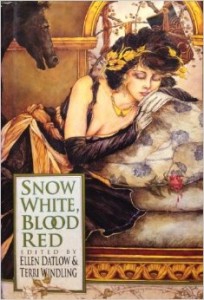 Laurie Thayer penned this review.
Laurie Thayer penned this review.![]()
When most people think of fairies, they think of Peter Pan’s tiny friend Tinkerbell or of the Wizard of Oz’s distressingly pink Glinda the Good, and when they think of fairy tales, they remember sitting in a darkened theatre watching a very blonde Cinderella sing to assorted talking vermin. Most people are not aware that the saccharine stories that they remember from their childhood have much darker origins or that the stories were not originally meant for children at all.
Snow White, Blood Red is the first in a series of books intended to bring fairy tales back from the nursery where they were relegated during Victorian times. Although there are light, frothy tales in this collection, dark, sensual stories predominate. There are very few “happily-ever-afters.” These are fairy tales for adults, where Little Red Riding Hood is a nubile teenager and the Big Bad Wolf is a gentleman who marries Red’s mother so that he has access to Red, who is a knowing accomplice.
Among the twenty writers represented here are such stars of the fantasy field as Charles de Lint, Patricia McKillip, Jane Yolen, Neil Gaiman, Esther Friesner and Tanith Lee. Editors Ellen Datlow and Terri Windling offer introductory essays on the history and impact of fairy tales. Windling refers to them as marchen, a German term, which equates roughly to “tales of wonder or enchantment.” Datlow offers up her thoughts on dark images and horror in the original tales.
The first story in the book, “Like a Red, Red Rose,” is by Susan Wade. Although this story has many fairy tale elements, it is not based on any specific tale, but is an original story combining different motifs. In a cottage deep in the woods the witch Martine lives with her daughter Blanche, who has never been allowed to socialize with others. Then comes the day when she meets a prince in the woods and from that time on, Blanche’s life is never the same. What she finally learns about herself at the story’s end makes for a very moving finale.
Tanith Lee’s story “Snow-Drop” is a take on the story of Snow White, but this from the stepmother’s point of view. The story is more science fiction than fantasy; the elements of the Snow White story, the stepmother, the child red as blood, white as snow and black as ebony, the seven dwarfs, even the poisoned apple are all here, but the setting is far from the deep woods of the original. It all conspires to leave the reader feeling rather sorry for the stepmother.
“The Princess in the Tower” by Elizabeth A. Lynn is a whimsical version of the story of Rapunzel. Margheritina is a young girl who, unlike all her friends and relations, doesn’t feel the need to eat four or five helpings of pasta at each meal. Eventually branded mad, she decides to act the part until she meets a handsome stranger and runs off with him. How Margheritina and her “prince” find happiness is indeed charming.
Another witty story is Caroline Stevermer and Ryan Edmonds’s “The Springfield Swans.” This brings the tale “The Wild Swans” to a Midwestern baseball field, with amusing results. When Annie and her brothers annoy their stepmother by mentioning baseball at their father’s funeral, the result is a little more than they expected. Only Annie’s resolve to help her brothers can save the day and help Springfield win the big game.
The stories in this collection will leave you thinking and wanting more. Fortunately, the editors also include an extensive list of suggested reading at the end of the book, so when you are finished with this one, you can hunt out some of the original tales or make up your own.
(Avon Books, 1993)
